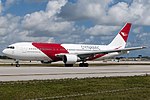Rainbow Interchange
1991 establishments in FloridaAll pages needing factual verificationExpressways in Broward County, FloridaInterstate 95Road interchanges in Florida ... and 2 more
Transportation in Fort Lauderdale, FloridaUse mdy dates from September 2018

The Rainbow Interchange was a four–level stack interchange located in Fort Lauderdale, Florida near the Fort Lauderdale-Hollywood International Airport. The interchange connects two major highways in the area, I-95 (leading to Miami and West Palm Beach) and I-595 (leading to Davie and the airport). The interchange opened in 1991. While minor construction improvements and repainting have occurred since the opening of the interchange, the interchange is experiencing major additions throughout 2025 as part of the Florida Department of Transportation's 95 Express project.
Excerpt from the Wikipedia article Rainbow Interchange (License: CC BY-SA 3.0, Authors, Images).Rainbow Interchange
Ravenswood Road,
Geographical coordinates (GPS) Address Nearby Places Show on map
Geographical coordinates (GPS)
| Latitude | Longitude |
|---|---|
| N 26.08196 ° | E -80.168722 ° |
Address
Ravenswood Road
33312 , Dania Beach
Florida, United States
Open on Google Maps







